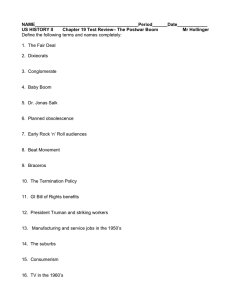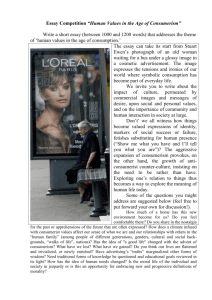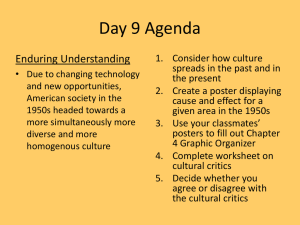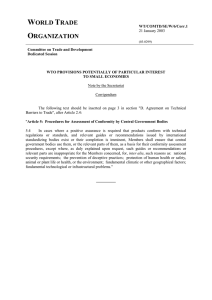The Fifties ‘The American Century’
advertisement
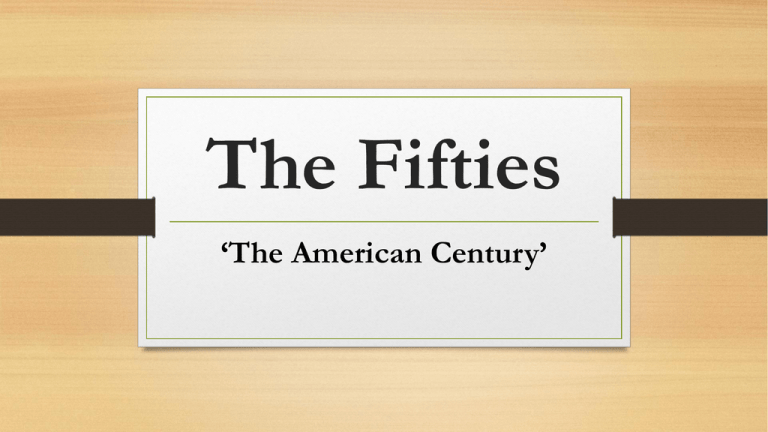
The Fifties ‘The American Century’ Today’s Lecture • ‘The American Century’ • Economic Growth • Women in the 1950s • McCarthyism and Jim Crow • Pop Culture • Consumerism • Kitchen Debates • The ‘Golden Age of Television • Social Impact of the Cold War • Invention of the Teenager • The Beat Movement • Conservatism and Conformity • Conclusion • The Baby Boom ‘The American Century’ - Henry Luce, publisher of Life • Europe recovering from WWII • 1945: US produced half of manufactured goods in the world • US goods sought after: necessity and want • Music; fashion; movies; technology • Age of prosperity, patriotism and hope • Underlying anxiety, dissatisfaction and despair • “This is a dream era, this is what everyone was waiting through the blackouts for. The Great American boom is on”. – Fortune, 1946. Economic Growth • Shift from wartime production to peacetime manufacturing; high government spending • Increased production through automation; little competition; high export rate • Massive domestic consumer demand - high earnings & low outgoings in wartime • “Never again shall we allow another depression in the States” – Eisenhower • Military budget central to economy and employment • White growth outstripped non-white growth • Middle-Class phenomenon; still 40 million poor in the USA “America’s enormously productive economy demands that we make production a way of life, that we convert the buying and use of goods into rituals, that we seek our spiritual satisfaction, our ego satisfaction, in consumption. Goods must be burned up, worn out, replaced at an ever increasing rate” - Victor Lebow (1955) Consumerism • Over-productive economy made consumerism a necessity • 1949: first credit card issued. 1959: >10,000,000 cards • 1949: 40% of Americans were homeowners; 1959: ↑60% • The Serviceman’s Re-Adjustment Act (1944) – ‘GI Bill’ • Suburban housing developments • Labor-saving devices • The Car • Out-of-town convenience stores • Disposable income + increased leisure time + mobility = fast food restaurants; drive-in movies; shopping malls Disneyland, CA (1955) • Fast construction: began 1 year before opening • Built at a cost of $17 million • 2 lanes added to the nearby freeway • Symbol of its time and of America • The park’s opening was premiered live on ABC • Promoted rampant consumerism and US exceptionalism • Designed to appear larger than it was – forced perspective • Walkways designed to increase walking time (shopping time) • Promoted a simple and traditional view of American life • Disney’s father worked at the Columbian Exposition Invention of the ‘Teenager’ • Rise in importance of education (GI Bill/ Cold War) and white collar work created a new sub-set of Americans • Disposable Income: Affluent parents/ part-time work • Teenage culture: records; movie tickets; fashion; sock hops; diners; cars • Juvenile Delinquency • Bored teenagers; dissatisfaction; drop-outs; anger • New; different; individuality; independence; confidence • Immigrant culture • Caused serious divisions between first and second generation immigrants as children assimilated. The Kitchen Debate • July 24th 1959: American National Exhibition: Sokolniki Park, Moscow • Took place between Vice President Richard Nixon and Soviet Premier Nikita Khrushchev • Showcase for the US’s technological advances • Displayed a ‘typical’ American home: • “This house can be bought for $14,000, and most Americans can buy a home in the bracket of $10,000 to $15,000” • “Khrushchev: We have steel workers and peasants who can afford to spend $14,000 for a house. Your American houses are built to last only 20 years so builders could sell new houses at the end. We build firmly. We build for our children and grandchildren”. • https://www.youtube.com/watch?v=z6RLCw1OZFw Social Impact of the Cold War • Influenced every aspect of life • Movies reflected anticommunist suspicions and tensions • Motherhood; consumerism; work ethic; conversation • Fear of the Atom Bomb • (1959) 2/3 Americans listed the A-Bomb as the US’s most pressing problem • This fear enabled the widespread hysteria of Communist witch hunts in the mid 1950s Conservatism and Conformity • Suburban life encouraged uniformity and observation • Rise of corporatism: conformity over individualism in the workplace • ‘Women’s place’ reinforced by suburban culture and housing structure • African Americans denied houses in white areas • Middle-class, conservative, Christian stronghold • Dissatisfaction; claustrophobia; repression • “One of the worst decades in the history of man” - Norman Mailer The Baby Boom • Post WWII phenomenon • Worldwide • Most prominent in the USA • Sociological causes • • • • Delayed childbirth Drop in average marriage age Rise in average number of children per household Population rose dramatically after WWII despite unusually low immigration The Baby Boom • Children are an ‘impregnable bulwark’ of democracy – Louisa Randall Church, 1946. • Uniformity of the ‘traditional’ household’ • Children as America’s future • As weapons for the Cold War effort • Paternal involvement • Avoidance of ‘sissies’ • The ‘feminine mystique’ • Image of women as ‘happy housewife heroines’ who relished their work inside the home and desired nothing more. Women in the 1950s • Proscribed Gender Roles • Widening opportunities • Workplace/ Higher Education • Dissatisfaction • Juvenile Delinquency • Divorce • Origins of the Women’s movement McCarthyism/ Jim Crow • Inextricably connected both to each other and to this week’s topic • Major Themes: • Communism/ Cold War/ Fear • Conformity • Conservatism • Discrimination • (McCarthyism covered in detail next week) 50s Pop Culture Music • ‘Rock and Roll’ coined in 1951 by radio DJ Alan Freed • phrase meant dancing and sex in African-American vernacular • Union of cultures; Based on R&B music mixed with country and • 1956: Heartbreak Hotel – Elvis most popular musician in US history western • Decried as a symptom of “dishonesty, violence, lust and degeneration” Movies • Dominated by technical enhancements: Cinemascope; vistavision; cinemarama; 3D Cinemas • Historical; fantasy; musicals/ paranoia; realism; noir • TV caused a dramatic drop-off in cinema attendance • Movies not important to 50s culture; 50s important to cinema The ‘Golden Age’ of Television • 50% of American households had a TV set by 1959 • Overtook radio in popularity in 1949; many shows transferred • Spurred the sale of ‘TV dinners’ that could be eaten on your lap in front of the TV set • Promoted a traditional (idealised) image of US • Particularly of family life: Leave it to Beaver; The Honeymooners; The Adventures of Ozzie and Harriet; The Donna Reed Show; Father Knows Best • No racial divides (no minorities); no poverty; no immigrants; no religious diversity; no disabilities • Advertising • Political Implications Beat Generation • So named because… • Alan Ginsberg/Jack Kerouac/ Laurence Ferlinghetti/ William Burroughs/ Neal Cassady • Greenwich Village/ San Francisco/ City Lights Bookstore • Non-conformist: hallucinogenic drugs; casual sex; homosexuality; a-political • Forerunner of 1960s Counterculture • ‘Beatniks’ (1958) • Howl/ On The Road/ Naked Lunch • Obscenity Trial (1957) • "who let themselves be fucked in the ass by saintly motorcyclists, and screamed with joy" Conclusion • ‘Golden Age’ of America • Nuclear Family/Conformity/ Stability/ Patriotism/ Safety/ Contentment • Illusion/ Misremembered • Escalation of the Cold War/ Hot Wars/ Unhappiness/Changing Times • Undercurrent of Rebellion • Juvenile Delinquency/ Drop Outs/ Civil Rights/Women’s/ Student Movement Next Week… McCarthyism
